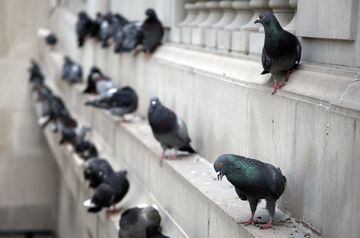What Is Bird Control
Bird control is sometimes known as bird proofing. This is the management of bird populations to reduce potential conflicts between pest birds and humans. This type of bird control typically involves methods such as habitat modification, exclusionary barriers, bird proofing, deterrents, and lethal control (e.g., trapping or hunting).
Bird control is used to mitigate nuisance behaviour caused by pest birds such as noise pollution, roosting on buildings, fouling sidewalks, and crop damage.
Bird control is also used to reduce potential public health risks from bird-carried diseases, such as avian flu, salmonellosis, and histoplasmosis. For these reasons, bird control has become an important part of many public health strategies for controlling the spread of disease.
Proper implementation of bird control and bird proofing can prevent unnecessary harm to pest birds, mitigate public health risks, and reduce the negative impacts of human-bird conflict. Bird control solutions should be implemented in a humane and ecologically sound manner. This includes careful consideration of any potential environmental or public health risks posed by the methods used.
What Are Considered Pest Birds?
Pest birds are species of birds that cause nuisance behaviour or public health risks. Common pest bird species include pigeons, starlings, crows, seagulls, geese, and blackbirds. These wild birds can be a nuisance due to the amount of noise they make or their habit of roosting on buildings. They can also cause public health risks due to the diseases they can carry. Bird proofing is common to help deter pest birds.
Any bird can become a pest bird if enough of them are able to gather and breed. A bird problem or bird infestation could include any type of bird. If you run a food business, then human health and safety should be your main priority, and keeping birds under control around your business will be essential.
It's not only food businesses that can suffer from bird problems. For example, if you have solar panels on your property, birds can mean they have limited effectiveness and this can be damaging to your investment. Any bird can cause damage to property through the accumulation of nests, nesting materials, bird droppings and feathers.
Relying on DIY bird control measures won't always be effective and it's a good idea to call in the professionals for help deterring birds from your land or property. The following bird proofing methods can be highly effective when implemented correctly.

Bird Control In City Areas
What Are The Most Popular Bird Control Methods?
The most common methods of bird control include habitat modification, exclusionary barriers, bird proofing, deterrents, and lethal control (e.g., trapping or hunting). Often, the best way to deter pest birds is through habitat modification. This involves changing the environment to make it less attractive to birds by removing food sources or nesting sites.
Exclusionary barriers and bird proofing such as bird netting or bird spikes can be used to prevent birds from roosting on buildings. Deterrents such as sound devices, flashing lights, water cannons, and chemical repellents can be used to scare birds away from certain areas. Lethal control should only be used as a last resort when all other methods have failed.
What Bird Species Are Protected?
Many species of birds are protected by national and international laws. It is important to be aware of these laws before implementing any type of bird control measure. All lethal control measures should be avoided if possible, as they can have a negative impact on bird populations and ecosystems.
It's also worth noting that certain species may not be affected by traditional bird control methods due to their high level of adaptability or intelligence. In this instance, you would need to adjust your bird proofing methods to help control birds around your property.
Bird control is an important tool for managing conflicts between humans and birds in order to reduce public health risks and mitigate nuisance behaviour. However, it is important to use humane and ecologically sound methods when implementing bird control strategies.
Careful consideration must also be taken regarding the protection of endangered or threatened species, as well as any potential environmental or public health risks posed by the methods used.
What Can I Do About Bird Droppings?
Bird droppings can be a nuisance, particularly when they accumulate on buildings or sidewalks. To reduce the number of droppings, it is important to remove food sources and make nesting sites difficult to access.
Professional bird control methods will always complete this in a humane way, in line with the British Pest Control Association guidelines and the Wildlife and Countryside Act.
After removing birds from an area, the cleanup operation can begin. It's advisable to use high-pressure cleaning to remove all traces of the pests from your property, as these can carry a whole host of unpleasant pathogens.